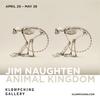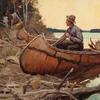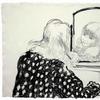George Caleb Bingham's Great American Masterpiece, The Jolly Flatboatmen, is Acquired by the National Gallery of Art, Washington
- WASHINGTON, DC
- /
- June 01, 2015
George Caleb Bingham's masterpiece, The Jolly Flatboatmen (1846)—considered one of the greatest American genre paintings ever made—has entered the collection of the National Gallery of Art, Washington. Known as "the Missouri artist," Bingham was fascinated with American frontier life and is particularly well known for his paintings of trappers and boatmen along the Mississippi and Missouri rivers. The purchase of the painting from the collection of the Richard and Jane Manoogian Foundation was made possible by the Gallery's Patrons' Permanent Fund.
The Jolly Flatboatmen is currently on tour in the exhibition Navigating the West: George Caleb Bingham and the River, which began last October at the Amon Carter Museum of American Art, Fort Worth, Texas. The exhibition closed at the Saint Louis Art Museum on May 17, and travels to the Metropolitan Museum of Art from June 17 through September 20. The Jolly Flatboatmen will go on view in the National Gallery of Art's West Building in October 2015.
"The Jolly Flatboatmen is among the first distinctly American paintings that capture the allure of Western expansion during the mid-19th century," said Earl A. Powell, III, director, National Gallery of Art. "The American masterpiece has had a regular presence at the Gallery since 1956, thanks to the generosity of its past owners, the Pell family and Richard Manoogian. It joins two other outstanding paintings—Mississippi Boatman (1850) and Cottage Scenery (1845)—and two works on paper by Bingham in the Gallery's collection."
The painting was also featured in two exhibitions: American Paintings from the Manoogian Collection at the National Gallery of Art in 1989, which traveled to San Francisco, New York, and Detroit, and George Caleb Bingham at the Saint Louis Museum of Art and the Gallery in 1990.
Born in Virginia in 1811 and raised in Missouri, Bingham began his career as a portrait painter and was largely self-taught. It was not until about 1845 that he began painting his most notable works—genre scenes featuring a wide range of colorful characters that lived and worked on the Mississippi and Missouri rivers. These lively compositions remain among the most important portrayals of life at the gateway to the Western frontier.
In The Jolly Flatboatmen, Bingham placed his central dancing figure at the apex of a triangular composition. On either side of the dancer, a fiddler plays a tune while another boatman keeps time on a frying pan and the rest of the men lounge on the deck as the boat floats downriver. In the foreground, Bingham included several remarkable still-life elements: a shirt drying in the sun, a coonskin, and a coiled rope. By 1846, when Bingham completed this painting, flatboats were quickly being replaced by steam-powered vessels that could haul freight at significantly faster speeds.
The American Art Union, based in New York City, was instrumental in Bingham's artistic career. This organization provided artists not only exhibition space, but also helped to disseminate their art to a broader public. In 1846, the Union purchased The Jolly Flatboatmen and included the work in its annual raffle. The painting was awarded to Benjamin van Schaick, a grocer living in New York. Bingham's spirited river scene became wildly popular through the circulation of printed reproductions, including 10,000 mezzotints of the painting distributed by The American Art Union to its members in 1847 and two lithographs produced by Currier & Ives in 1867 and 1870.
Hoping to profit from the original painting's popularity, Bingham completed two additional versions on the theme. The first, Jolly Flatboatmen in Port (1857), now at the Saint Louis Art Museum, repeats the triangular composition with additional figures. The second version, The Jolly Flatboatmen (1877–78), currently in the collection of the Terra Foundation for American Art, Chicago, is a smaller painting with just seven figures. However, the original composition of The Jolly Flatboatmen remains Bingham's best-known work.
After disappearing from view for more than a century, The Jolly Flatboatmen was purchased by William Pell sometime prior to 1954 when it was exhibited at the Saint Louis Art Museum. It remained in the collection of the Pell family and the Pell Family Trust until Richard A. Manoogian purchased the painting in 1986.
















